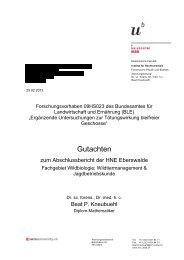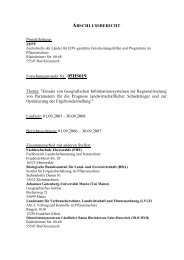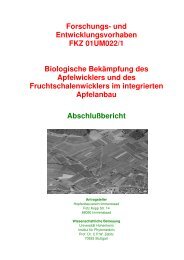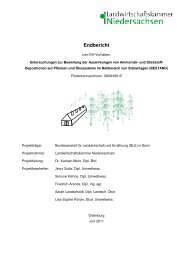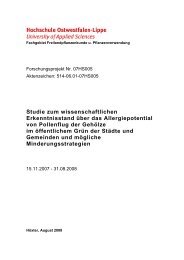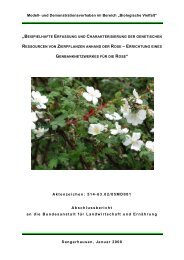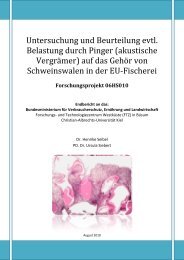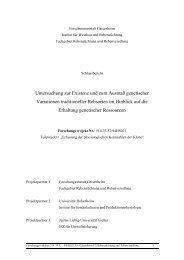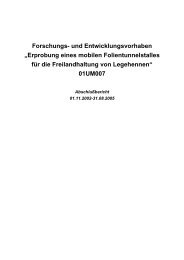Abschlussbericht Projekt: „Verminderung der ... - BLE
Abschlussbericht Projekt: „Verminderung der ... - BLE
Abschlussbericht Projekt: „Verminderung der ... - BLE
Sie wollen auch ein ePaper? Erhöhen Sie die Reichweite Ihrer Titel.
YUMPU macht aus Druck-PDFs automatisch weboptimierte ePaper, die Google liebt.
Nutrient concentrations in potato (Solanum tuberosum) tubers in comparison<br />
with their different susceptibility towards blackspot<br />
Wulkow A 1 , Pawelzik E 1*<br />
1 Quality of Plant Products Section, Department of Crop Sciences, University of Goettingen<br />
Abstract<br />
The blackspot index (BSI) was determined in potato tubers harvested at different stages of<br />
haulm maturity and after storing tubers for several months. Pre-harvested tubers had a<br />
lower BSI compared to tubers harvested two weeks later (main harvest) whereas the BSI of<br />
stored tubers varied from year to year. The BSI increased when cultivar specific gravity<br />
was relative high. However, the concentrations of K, P, Mg, Ca, Fe, B and Se were not<br />
related to the BSI of tubers. Irrigation to attain optimum soil moisture conditions during<br />
periods of vegetation enhanced nutrient sufficiency and reduced the potential damage inflicted<br />
on tubers. Nutrient uptake was nearly complete when the majority of tuber growth<br />
ends approximately 150 days after planting. Although extreme nutrient deficiency was not<br />
observed nutrient concentrations of tubers particularly depended on nutritional interactions<br />
influenced the BSI also.<br />
Keywords: specific gravity, maturity, storage, fertilization, potassium, phosphorus,<br />
magnesium, calcium, iron, boron, selenium<br />
Introduction<br />
Potato tuber are rich in parenchymatous tissue including water as a predominant component<br />
and shows a lack of specialized thickened tissue (Peterson et al. 1985). This characteristic<br />
determine tubers susceptibility towards various forms of external and internal damage<br />
that occur after impact caused during commercial production, harvest and/or post-harvest<br />
handling (Thornton and Timm 1990). In contrast to external damage, internal damage is<br />
not visible before cutting or peeling the tuber. The symptoms of internal damage may or<br />
may not include visible tissue fracture. If there is no visible fracture, damage sometimes<br />
includes the development of floury-white regions in clear contrast to the cream background<br />
of undamaged tissue finally resulting in the formation of grey and black coloured pigment<br />
melanin. This symptom is usually referred to as internal bruising particularly termed<br />
blackspot (McGarry et al. 1996). A major factor on the intensity of blackspot is the speed,<br />
distance and type of impact as well as the genetic and environmental diversity. In general<br />
tubers of a given cultivar or among cultivars subjected to a known impact do not express<br />
the same degree of blackspot. This suggested that there is at least one component influencing<br />
blackspot susceptibility among tubers (Thornton and Timm 1990). Dry matter has a<br />
major influence on blackspot susceptibility, whereas dry matter primary depends on to the<br />
starch concentration of tubers (Wulkow et al. in preparation) and, therefore, it is highly<br />
variable. Even the alternation of the water concentration influences blackspot susceptibility<br />
164




